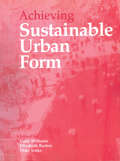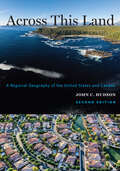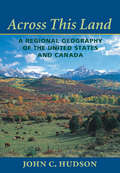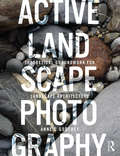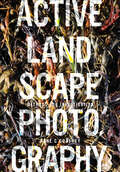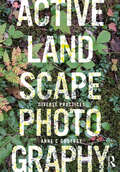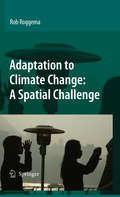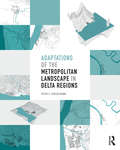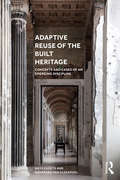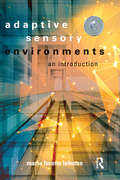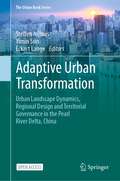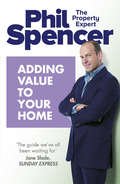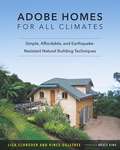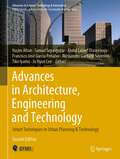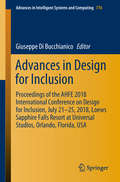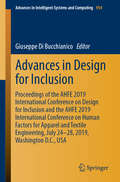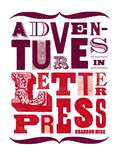- Table View
- List View
Achieving Sustainable Urban Form
by Elizabeth Burton Mike Jenks Katie WilliamsAchieving Sustainable Urban Form represents a major advance in the sustainable development debate. It presents research which defines elements of sustainable urban form - density, size, configuration, detailed design and quality - from macro to micro scale. Case studies from Europe, the USA and Australia are used to illustrate good practice within the fields of planning, urban design and architecture.
Achieving Sustainable Urban Form
by Katie Williams Elizabeth Burton Mike JenksAchieving Sustainable Urban Form represents a major advance in the sustainable development debate. It presents research which defines elements of sustainable urban form - density, size, configuration, detailed design and quality - from macro to micro scale. Case studies from Europe, the USA and Australia are used to illustrate good practice within the fields of planning, urban design and architecture.
Across This Land: A Regional Geography of the United States and Canada (Creating the North American Landscape)
by John HudsonBased on decades of research and written in clear, concise prose by one of the foremost geographers in North America, John C. Hudson's Across This Land is a comprehensive regional geography of the North American continent. Dividing the terrain into ten regions, which are then subdivided into twenty-seven smaller areas, Hudson's brisk narrative reveals the dynamic processes of each area's distinctive place-specific characteristics. Focusing on how human activities have shaped and have been shaped by the natural environment, Hudson considers physical, political, and historical geography. He also highlights related topics, including resource exploitation, economic development, and population change. Praised in its first edition as a readable and reliable interpretation of United States and Canadian geography, the revised Across This Land retains these strengths while adding substantial new material. Incorporating the latest available population and economic data, this thoroughly updated edition includes• reflections on new developments, such as resource schemes, Native governments in Atlantic Canada, and the role of climate change in the Arctic• a new section focused on the US Pacific insular territories west of Hawaii• evolving views of oil and gas production resulting from the introduction of hydraulic fracturing• revised text and maps involving agricultural production based on the 2017 Census of Agriculture• current place names• more than 130 photographsThe most extensive regional geography of the North American continent on the market, Hudson's Across This Land will continue as the standard text in geography courses dealing with Canada and the United States, as well as a popular reference work for scholars, students, and lay readers.
Across This Land: A Regional Geography of the United States and Canada (Creating the North American Landscape)
by John C. HudsonBased on decades of research and written in clear, concise prose by one of the foremost geographers in North America, John C. Hudson's Across This Land is a comprehensive regional geography of the North American continent.Clearly organized, the book divides the entire United States and Canada into six major regions, then further subdivides them into twelve smaller areas. Hudson emphasizes each region or area's distinguishing place-specific attributes, including—to a larger degree than previous regional geographies—political considerations. In this way, the book tells the story of each region, relying on a brisk narrative that reveals the dynamic processes of their distinctive characteristics. The first extensive regional geography of the North American continent in over seventy-five years, Hudson's Across This Land will become the standard text in geography courses dealing with Canada and the U.S. as well as a popular reference work for scholars, students, and lay readers.
Across This Land: A Regional Geography of the United States and Canada (Creating the North American Landscape)
by John HudsonBased on decades of research and written in clear, concise prose by one of the foremost geographers in North America, John C. Hudson's Across This Land is a comprehensive regional geography of the North American continent. Dividing the terrain into ten regions, which are then subdivided into twenty-seven smaller areas, Hudson's brisk narrative reveals the dynamic processes of each area's distinctive place-specific characteristics. Focusing on how human activities have shaped and have been shaped by the natural environment, Hudson considers physical, political, and historical geography. He also highlights related topics, including resource exploitation, economic development, and population change. Praised in its first edition as a readable and reliable interpretation of United States and Canadian geography, the revised Across This Land retains these strengths while adding substantial new material. Incorporating the latest available population and economic data, this thoroughly updated edition includes• reflections on new developments, such as resource schemes, Native governments in Atlantic Canada, and the role of climate change in the Arctic• a new section focused on the US Pacific insular territories west of Hawaii• evolving views of oil and gas production resulting from the introduction of hydraulic fracturing• revised text and maps involving agricultural production based on the 2017 Census of Agriculture• current place names• more than 130 photographsThe most extensive regional geography of the North American continent on the market, Hudson's Across This Land will continue as the standard text in geography courses dealing with Canada and the United States, as well as a popular reference work for scholars, students, and lay readers.
Active Landscape Photography: Theoretical Groundwork for Landscape Architecture
by Anne C GodfreyPhotographs play a hugely influential but largely unexamined role in the practice of landscape architecture and design. Through a diverse set of essays and case studies, this seminal text unpacks the complex relationship between landscape architecture and photography. It explores the influence of photographic seeing on the design process by presenting theoretical concepts from photography and cultural theory through the lens of landscape architecture practice to create a rigorous, open discussion. Beautifully illustrated in full color throughout, with over 200 images, subjects covered include the diversity of everyday photographic practices for design decision making, the perception of landscape architecture through photography, transcending the objective and subjective with photography, and deploying multiplicity in photographic representation as a means to better represent the complexity of the discipline. Rather than solving problems and providing tidy solutions to the ubiquitous relationship between photography and landscape architecture, this book aims to invigorate a wider dialogue about photography's influence on how landscapes are understood, valued and designed. Active photographic practices are presented throughout for professionals, academics, students and researchers.
Active Landscape Photography: Theoretical Groundwork for Landscape Architecture
by Anne C GodfreyPhotographs play a hugely influential but largely unexamined role in the practice of landscape architecture and design. Through a diverse set of essays and case studies, this seminal text unpacks the complex relationship between landscape architecture and photography. It explores the influence of photographic seeing on the design process by presenting theoretical concepts from photography and cultural theory through the lens of landscape architecture practice to create a rigorous, open discussion. Beautifully illustrated in full color throughout, with over 200 images, subjects covered include the diversity of everyday photographic practices for design decision making, the perception of landscape architecture through photography, transcending the objective and subjective with photography, and deploying multiplicity in photographic representation as a means to better represent the complexity of the discipline. Rather than solving problems and providing tidy solutions to the ubiquitous relationship between photography and landscape architecture, this book aims to invigorate a wider dialogue about photography's influence on how landscapes are understood, valued and designed. Active photographic practices are presented throughout for professionals, academics, students and researchers.
Active Landscape Photography: Methods for Investigation (Active Landscape Photography)
by Anne C GodfreyHow can photography be transformed into an active process of investigation for landscape architecture and environmental design? The second book in Godfrey’s series, Active Landscape Photography, presents engaged photographic methods that turn photography into a rigorous, thoughtful endeavor for the research, planning and design of landscape places. Photography is the most ubiquitous and important form of representation in these disciplines. Yet photography is not specifically taught as a core skill within these fields. This book creates a starting point for filling this gap. Concepts and working methods from contemporary photography and critical cultural theories are contextualized into situations encountered in the daily practice of landscape architecture and environmental design. These methods can be integrated into practices in academic and professional settings or picked up and self-taught by an individual reader. Part I: Methods presents easily accessible approaches to photography creating a core set of active skills. Part II: Practices discusses working methods of specific contemporary photographers and extrapolates their practices into common extrapolates their practices into common planning and design situations. Contemporary photographers presented include Richard Misrach, Dawoud Bey, Duane Michals, Latoya Ruby Frazier, Mark Klett, Sophie Calle, Joe Deal, Robert Adams, Naima Green, Bernd and Hilla Becher, Stephen Shore, David Hockney, Amy Sherald, William Christenberry, Jeff Wall, and Sohei Nishino. Beautifully illustrated in full color with over 150 images by Godfrey, her students, and contemporary photographers, this book provides both clear guidelines for a set of diverse methods as well as a deeper discussion about the implications of making and using photography in environmental design for professionals, academics, students and researchers.
Active Landscape Photography: Methods for Investigation (Active Landscape Photography)
by Anne C GodfreyHow can photography be transformed into an active process of investigation for landscape architecture and environmental design? The second book in Godfrey’s series, Active Landscape Photography, presents engaged photographic methods that turn photography into a rigorous, thoughtful endeavor for the research, planning and design of landscape places. Photography is the most ubiquitous and important form of representation in these disciplines. Yet photography is not specifically taught as a core skill within these fields. This book creates a starting point for filling this gap. Concepts and working methods from contemporary photography and critical cultural theories are contextualized into situations encountered in the daily practice of landscape architecture and environmental design. These methods can be integrated into practices in academic and professional settings or picked up and self-taught by an individual reader. Part I: Methods presents easily accessible approaches to photography creating a core set of active skills. Part II: Practices discusses working methods of specific contemporary photographers and extrapolates their practices into common extrapolates their practices into common planning and design situations. Contemporary photographers presented include Richard Misrach, Dawoud Bey, Duane Michals, Latoya Ruby Frazier, Mark Klett, Sophie Calle, Joe Deal, Robert Adams, Naima Green, Bernd and Hilla Becher, Stephen Shore, David Hockney, Amy Sherald, William Christenberry, Jeff Wall, and Sohei Nishino. Beautifully illustrated in full color with over 150 images by Godfrey, her students, and contemporary photographers, this book provides both clear guidelines for a set of diverse methods as well as a deeper discussion about the implications of making and using photography in environmental design for professionals, academics, students and researchers.
Active Landscape Photography: Diverse Practices (Active Landscape Photography)
by Anne C GodfreyDiverse Practices, the third book in the Active Landscape Photography series, presents a set of unique photographic examples for site-specific investigations of landscape places. Contributed by authors across academia, practice and photography, each chapter serves as a rigorous discussion about photographic methods for the landscape and their underlying concepts. Chapters also serve as unique case studies about specific projects, places and landscape issues. Project sites include the Miller Garden, Olana, XX Miller Prize and the Philando Castile Peace Garden. Landscape places discussed include the archeological landscapes of North Peru, watery littoral zones, the remote White Pass in Alaska, Sau Paulo and New York City’s Chinatown. Photographic image-making approaches include the use of lidar, repeat photography, collage, mapping, remote image capture, portraiture, image mining of internet sources, visual impact assessment, cameraless photography, transect walking and interviewing. These diverse practices demonstrate how photography, when utilized through a set of specific critical methods, becomes a rich process for investigating the landscape. Exploring this concept in relationship to specific contemporary sties and landscape issues reveals the intricacy and subtlety that exists when photography is used actively. Practitioners, academics, students and researchers will be inspired by the underlying concepts of these examples and come away with a better understanding about how to create their own rigorous photographic practices.
Active Landscape Photography: Diverse Practices (Active Landscape Photography)
Diverse Practices, the third book in the Active Landscape Photography series, presents a set of unique photographic examples for site-specific investigations of landscape places. Contributed by authors across academia, practice and photography, each chapter serves as a rigorous discussion about photographic methods for the landscape and their underlying concepts. Chapters also serve as unique case studies about specific projects, places and landscape issues. Project sites include the Miller Garden, Olana, XX Miller Prize and the Philando Castile Peace Garden. Landscape places discussed include the archeological landscapes of North Peru, watery littoral zones, the remote White Pass in Alaska, Sau Paulo and New York City’s Chinatown. Photographic image-making approaches include the use of lidar, repeat photography, collage, mapping, remote image capture, portraiture, image mining of internet sources, visual impact assessment, cameraless photography, transect walking and interviewing. These diverse practices demonstrate how photography, when utilized through a set of specific critical methods, becomes a rich process for investigating the landscape. Exploring this concept in relationship to specific contemporary sties and landscape issues reveals the intricacy and subtlety that exists when photography is used actively. Practitioners, academics, students and researchers will be inspired by the underlying concepts of these examples and come away with a better understanding about how to create their own rigorous photographic practices.
Adaptation to Climate Change: A Spatial Challenge
by Rob RoggemaAs it becomes clear that climate change is not easily within the boundaries of the 1990’s, society needs to be prepared and needs to anticipate future changes due to the uncertain changes in climate. So far, extensive research has been carried out on several issues including the coastal defence or shifting ecozones. However, the role spatial design and planning can play in adapting to climate change has not yet been focused on. This book illuminates the way adaptation to climate change is tackled in water management, ecology, coastal defence, the urban environment and energy. The question posed is how each sector can anticipate climate change by creating spatial designs and plans. The main message of this book is that spatial design and planning are a very useful tool in adapting to climate change. It offers an integral view on the issue, it is capable in dealing with uncertainties and it opens the way to creative and anticipative solutions. Dealing with adaptation to climate change requires a shift in mindset; from a technical rational way of thinking towards an integral proactive one. A new era in spatial design and planning looms on the horizon.
Adaptations of the Metropolitan Landscape in Delta Regions
by Peter C BosselmannAdaptations of the Metropolitan Landscape in Delta Regions is about environmental quality and the long term livability of urban areas. In decades to come, climate change will affect cities everywhere, but nowhere have the effects of climate change already been felt as strongly as in low-lying coastal cities, cities located in large river deltas and near tidal estuaries. This book reflects on the contribution that spatial planning and urban design can make to a complex discussion about how city form and landscapes will need to adapt within metropolitan areas. The book’s focus is on the urban form of three delta regions: the Pearl River Delta in Southern China; the Rhine, Maas, and Scheldt Delta in the Netherlands; and the San Francisco Bay Area in Northern California. The three regions differ greatly, but despite their different political systems, history, culture and locations in three different climate zones, all three regions will be forced to respond to similar issues that will trigger transformations and adaptations to their urban form. Richly illustrated in color with detailed diagrams, models, photographs and sketches, the book is written for students, scholars and practitioners of environmental planning, and designers who need to respond to the future form of cities in light of climate change. For the professions shaping the physical world of cities and regions, the challenge is not only one of designing physical geometries but of social consequences.
Adaptations of the Metropolitan Landscape in Delta Regions
by Peter C BosselmannAdaptations of the Metropolitan Landscape in Delta Regions is about environmental quality and the long term livability of urban areas. In decades to come, climate change will affect cities everywhere, but nowhere have the effects of climate change already been felt as strongly as in low-lying coastal cities, cities located in large river deltas and near tidal estuaries. This book reflects on the contribution that spatial planning and urban design can make to a complex discussion about how city form and landscapes will need to adapt within metropolitan areas. The book’s focus is on the urban form of three delta regions: the Pearl River Delta in Southern China; the Rhine, Maas, and Scheldt Delta in the Netherlands; and the San Francisco Bay Area in Northern California. The three regions differ greatly, but despite their different political systems, history, culture and locations in three different climate zones, all three regions will be forced to respond to similar issues that will trigger transformations and adaptations to their urban form. Richly illustrated in color with detailed diagrams, models, photographs and sketches, the book is written for students, scholars and practitioners of environmental planning, and designers who need to respond to the future form of cities in light of climate change. For the professions shaping the physical world of cities and regions, the challenge is not only one of designing physical geometries but of social consequences.
Adaptive Reuse of the Built Heritage: Concepts and Cases of an Emerging Discipline
by Bie Plevoets Koenraad Van CleempoelAdaptive reuse – the process of repairing and restoring existing buildings for new or continued use – is becoming an essential part of architectural practice. As mounting demographic, economic, and ecological challenges limit opportunities for new construction, architects increasingly focus on transforming and adapting existing buildings. This book introduces adaptive reuse as a new discipline. It provides students and professionals with the understanding and the tools they need to develop innovative and creative approaches, helping them to rethink and redesign existing buildings – a skill which is becoming more and more important. Part I outlines the history of adaptive reuse and explains the concepts and methods that lie behind new design processes and contemporary practice. Part II consists of a wide range of case studies, representing different time periods and strategies for intervention. Iconic adaptive reuse projects such as the Caixa Forum in Madrid and the Rijksmuseum in Amsterdam are discussed alongside less famous and spontaneous transformations such as the Kunsthaus Tacheles in Berlin, in addition to projects from Italy, Spain, Croatia, Belgium, Poland, and the USA. Featuring over 100 high-quality color illustrations, Adaptive Reuse of the Built Heritage is essential reading for students and professionals in architecture, interior design, heritage conservation, and urban planning.
Adaptive Reuse of the Built Heritage: Concepts and Cases of an Emerging Discipline
by Bie Plevoets Koenraad Van CleempoelAdaptive reuse – the process of repairing and restoring existing buildings for new or continued use – is becoming an essential part of architectural practice. As mounting demographic, economic, and ecological challenges limit opportunities for new construction, architects increasingly focus on transforming and adapting existing buildings. This book introduces adaptive reuse as a new discipline. It provides students and professionals with the understanding and the tools they need to develop innovative and creative approaches, helping them to rethink and redesign existing buildings – a skill which is becoming more and more important. Part I outlines the history of adaptive reuse and explains the concepts and methods that lie behind new design processes and contemporary practice. Part II consists of a wide range of case studies, representing different time periods and strategies for intervention. Iconic adaptive reuse projects such as the Caixa Forum in Madrid and the Rijksmuseum in Amsterdam are discussed alongside less famous and spontaneous transformations such as the Kunsthaus Tacheles in Berlin, in addition to projects from Italy, Spain, Croatia, Belgium, Poland, and the USA. Featuring over 100 high-quality color illustrations, Adaptive Reuse of the Built Heritage is essential reading for students and professionals in architecture, interior design, heritage conservation, and urban planning.
Adaptive Sensory Environments: An Introduction
by Maria Lorena Lehman***WINNER OF A NAUTILUS 2017 SILVER MEDAL BOOK AWARD*** Adaptive Sensory Environments: An Introduction presents a cutting-edge methodology for adaptive sensory design by fostering an inter-disciplinary approach in which aspects of neuroscience, biophilia, captology, nanotechnology, kinetics, and sensemaking all play critical roles in helping adaptive architecture "tune" to occupants. Furthermore, the book illustrates how adaptive sensory environments transform and uplift quality of life in entirely new ways, by strategically unlocking the potential that technological innovations bring. By teaching scholars, researchers, practitioners, specialists, and consultants how to design architecture that guides what emerging interactive technology can do, it allows them to see deeper into an architectural design, to extend beyond interaction and, ultimately, to build environments that adapt by changing and growing with their occupants’ immediate needs and long-term goals.
Adaptive Sensory Environments: An Introduction
by Maria Lorena Lehman***WINNER OF A NAUTILUS 2017 SILVER MEDAL BOOK AWARD*** Adaptive Sensory Environments: An Introduction presents a cutting-edge methodology for adaptive sensory design by fostering an inter-disciplinary approach in which aspects of neuroscience, biophilia, captology, nanotechnology, kinetics, and sensemaking all play critical roles in helping adaptive architecture "tune" to occupants. Furthermore, the book illustrates how adaptive sensory environments transform and uplift quality of life in entirely new ways, by strategically unlocking the potential that technological innovations bring. By teaching scholars, researchers, practitioners, specialists, and consultants how to design architecture that guides what emerging interactive technology can do, it allows them to see deeper into an architectural design, to extend beyond interaction and, ultimately, to build environments that adapt by changing and growing with their occupants’ immediate needs and long-term goals.
Adaptive Urban Transformation: Urban Landscape Dynamics, Regional Design and Territorial Governance in the Pearl River Delta, China (The Urban Book Series)
by Steffen Nijhuis Yimin Sun Eckart LangeThis open access book provides a cross-sectoral, integrative and multi-scale design and planning approach for adaptive urban transformation of fast urbanising deltas, taking the Pearl River Delta (China) as a case study. Deltaic areas are among the most promising regions in the world. Their strategic location and superior quality of their soils are core factors supporting both human development and the rise of these regions as global economic hubs. At the same time, however, deltas are extremely vulnerable to multiple threats from both climate change and urbanisation. These include an increased flood risk combined with the resulting loss of ecological and social-cultural values. To ensure a more sustainable future for these areas, spatial strategies are needed to strengthen resilience, i.e. help the systems to cope with their vulnerabilities as well as enhance their capacity to overcome natural and artificial threats.The book provides a unique approach that integrates research in urban landscape systems, territorial governance and visualisation techniques that will help to achieve more integrated and resilient deltas. Based on an assessment of the dynamics of change regarding the transformational cycles of natural and urban landscape elements, eco-dynamic regional design strategies are explored to reveal greater opportunities for the exploitation of natural and social-cultural factors within the processes of urban development.
Adding Value to Your Home
by Phil SpencerIs it really a good idea to install that expensive cappuccino maker when you haven't fitted a good working boiler or decent flooring? And what about the value added by sprucing up the bathroom (and losing that avocado suite with gold taps)? Will it be worth spending a fortune on expensive fittings or will B&Q do the job?In the complicated world of home improvements, it is every bit as important to know what not to do, as it is what to do, when planning where to focus your energies and spend your budget. Not everything adds value in cash terms, but some ideas could make your house easier to sell. Phil Spencer's Adding Value to Your Home is about both making your property a better place for you to live, and enhancing the value of your principal asset should you decide to sell. In a competitive property market it is crucial to get this right, and no one can help more than property guru Phil Spencer. Showing you how to attract the most attention from buyers and what will make your house sell quicker and for more cash, this book is packed full of practical advice, clear information and real-life case studies.From simple DIY projects or insulating the loft, to coming up with a well-planned and well-executed extension, Adding Value to Your Home is here to help you understand what could work best for you, and what will make the overall feel of your house more valuable in the eyes of a potential buyer.
Adobe Homes for All Climates: Simple, Affordable, and Earthquake-Resistant Natural Building Techniques
by Lisa Schroder Vince OgletreeThe lay-up of adobe bricks is an easy, forgiving way to achieve a solid masonry-wall system. Contrary to stereotypes, adobe is perfectly adaptable for use in cold, wet climates as well as hot and dry ones, and for areas prone to earthquakes. With its efficient use of energy, natural resources for construction, and minimal effort for long-term maintenance, it’s clear that the humble adobe brick is an ideal option for constructing eco-friendly structures throughout the world. The book is ideal both for first-time do-it-yourselfers and for experienced adobe builders seeking to improve their craft. Drawing on the experience of more than fifty major adobe projects since 1993, Adobe Homes for All Climates describes Adobe Building Systems’ patented reinforcement and scaffolding systems, showing readers how to construct adobe homes more easily and safely, and with superior strength, durability, structural integrity, and aesthetic appeal, as compared to earthen homes of the past. All aspects of adobe construction are covered, including making and laying adobe bricks, installing lintels and arches, conduits and pipes, doors and windows, top plates and bondbeams, ideal wall dimensions, adobe finishes, and other adobe construction components, such as the inexpensive use of scaffolding. These methods will produce a premium product that will meet and often exceed inspection standards. Equipped with this manual, you will be able to obtain a building permit, make adobe bricks swiftly, and confidently lay them up. You will be able to beautifully finish your adobe walls with earth plasters creating stunning colors and outstanding light effects and create a beautiful, energy-efficient home that will last for generations to come.
Advances in Architecture, Engineering and Technology: Smart Techniques in Urban Planning & Technology (Advances in Science, Technology & Innovation)
by Haşim Altan Samad Sepasgozar Abdullateef Olanrewaju Francisco José García Peñalvo Alessandro Gaetano Severino Tiko Iyamu Ju Hyun LeeThis book summarizes the latest studies regarding innovation in urban design and planning. It shares many tips and insights about sustainable solutions for the issues facing transport systems, innovative digital technologies, and ICT trends. The book touches upon the need to integrate the three fields of Architecture, Engineering, and Technology that have become indispensable. This is intended to respond to the increasing human needs and population growth in cities on one hand and to develop a holistic approach that helps overcome challenges to sustainability and environment management on the other hand. With the power of engineering in practice, problems of design and development once considered too complex to be dealt with other than empirically, intuitively, or by trial and error, are now becoming more solvable and applicable. This book offers strategies and solutions that enable designers to bring together knowledge in the fields of architecture, engineering, and technology to overcome challenges facing in modern times.
Advances in Design for Inclusion: Proceedings of the AHFE 2018 International Conference on Design for Inclusion, July 21-25, 2018, Loews Sapphire Falls Resort at Universal Studios, Orlando, Florida, USA (Advances in Intelligent Systems and Computing #776)
by Giuseppe Di BucchianicoThis book addresses a range of topics in design, such as universal design, design for all, digital inclusion, universal usability, and accessibility of technologies for people regardless of their age, financial situation, education, geographic location, culture and language. It especially focuses on accessibility for people with auditory, cognitive, neurological, and visual impairments, ageing populations, and mobility for those with special physical needs. The book explores some of the overlaps between inclusive design and web accessibility to help managers, designers, developers, policy makers, and researchers optimize their efforts in these areas. Based on the AHFE 2018 International Conference on Design for Inclusion, held on July 21–25, 2018, in Orlando, Florida, USA, it discusses new design technologies and highlights the disparate needs of the individuals within a community. Thanks to its multidisciplinary approach, it is a valuable resource for readers from various backgrounds, providing them a timely, practice-oriented guide to design for inclusion.
Advances in Design for Inclusion: Proceedings of the AHFE 2019 International Conference on Design for Inclusion and the AHFE 2019 International Conference on Human Factors for Apparel and Textile Engineering, July 24-28, 2019, Washington D.C., USA (Advances in Intelligent Systems and Computing #954)
by Giuseppe Di BucchianicoThis book addresses a range of topics in design, such as universal design; design for all; digital inclusion; universal usability; and accessibility of technologies regardless of users’ age, financial situation, education, geographic location, culture and language. It especially focuses on accessibility for people with auditory, cognitive, neurological, and visual impairments, ageing populations, and mobility for those with special physical needs. The book explores some of the overlaps between inclusive design and web accessibility to help managers, designers, developers, policy makers, and researchers optimize their efforts in these areas. Based on the AHFE 2019 International Conference on Design for Inclusion, held on July 24-28, held in Washington D.C., USA, it discusses new design technologies and highlights the disparate needs of the individuals within a community. Thanks to its multidisciplinary approach, it provides readers with various backgrounds with a timely, practice-oriented guide to design for inclusion.
Adventures in Letterpress
by Brandon MiseTactile, retro and idiosyncratic, hand-printed objects have an undeniable appeal, especially in a digital age. In recent years, the nearly obsolete craft of letterpress has been resurrected by artists and designers who have rescued cast-iron presses from basements and scrap yards. Adventures in Letterpress features over 200 examples of the resulting work: elegant cards, edgy broadsheets and everything in between. Beautiful, humorous and sometimes just plain weird, the projects featured in the book perfectly illustrate the vibrant future of this once-endangered medium.
